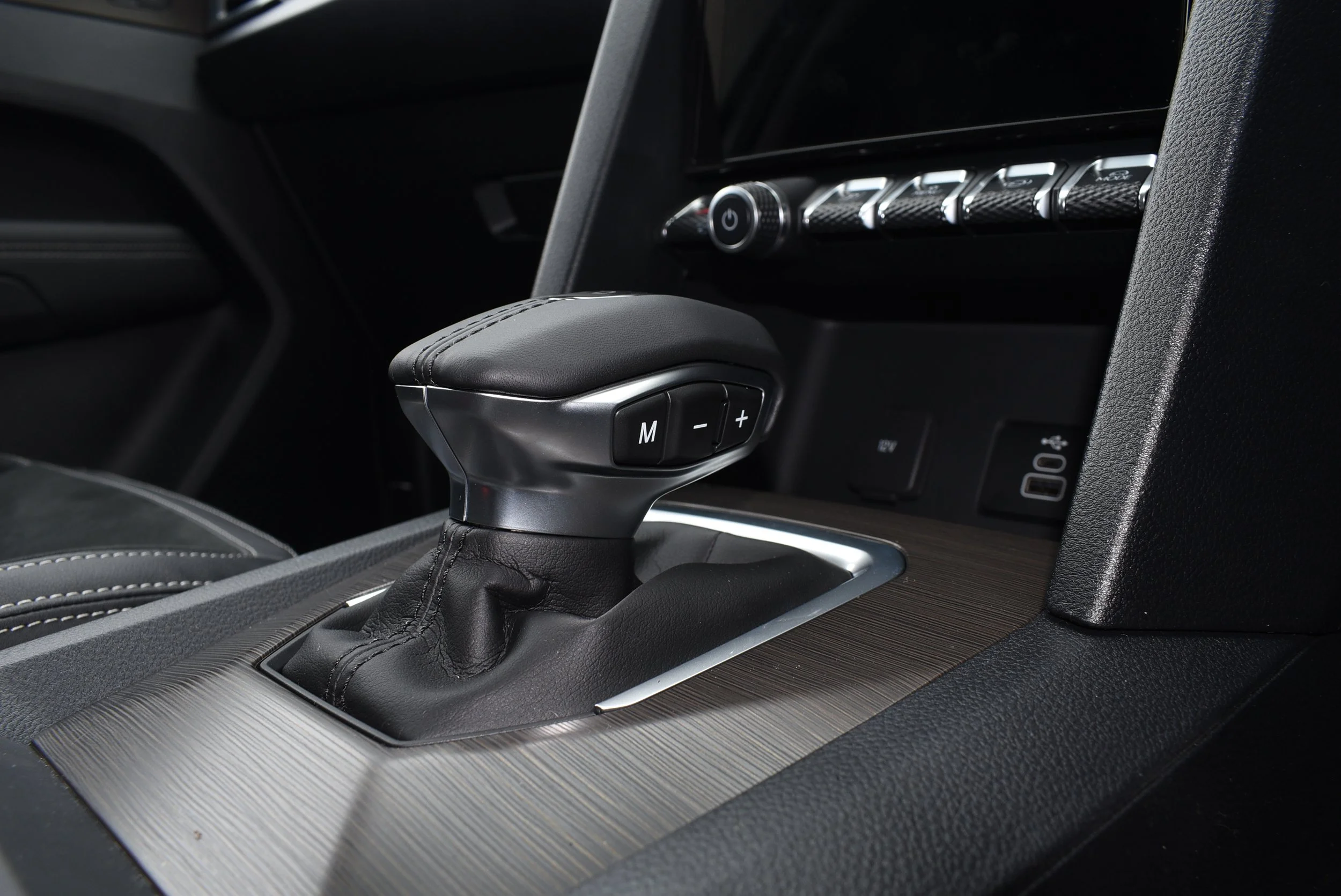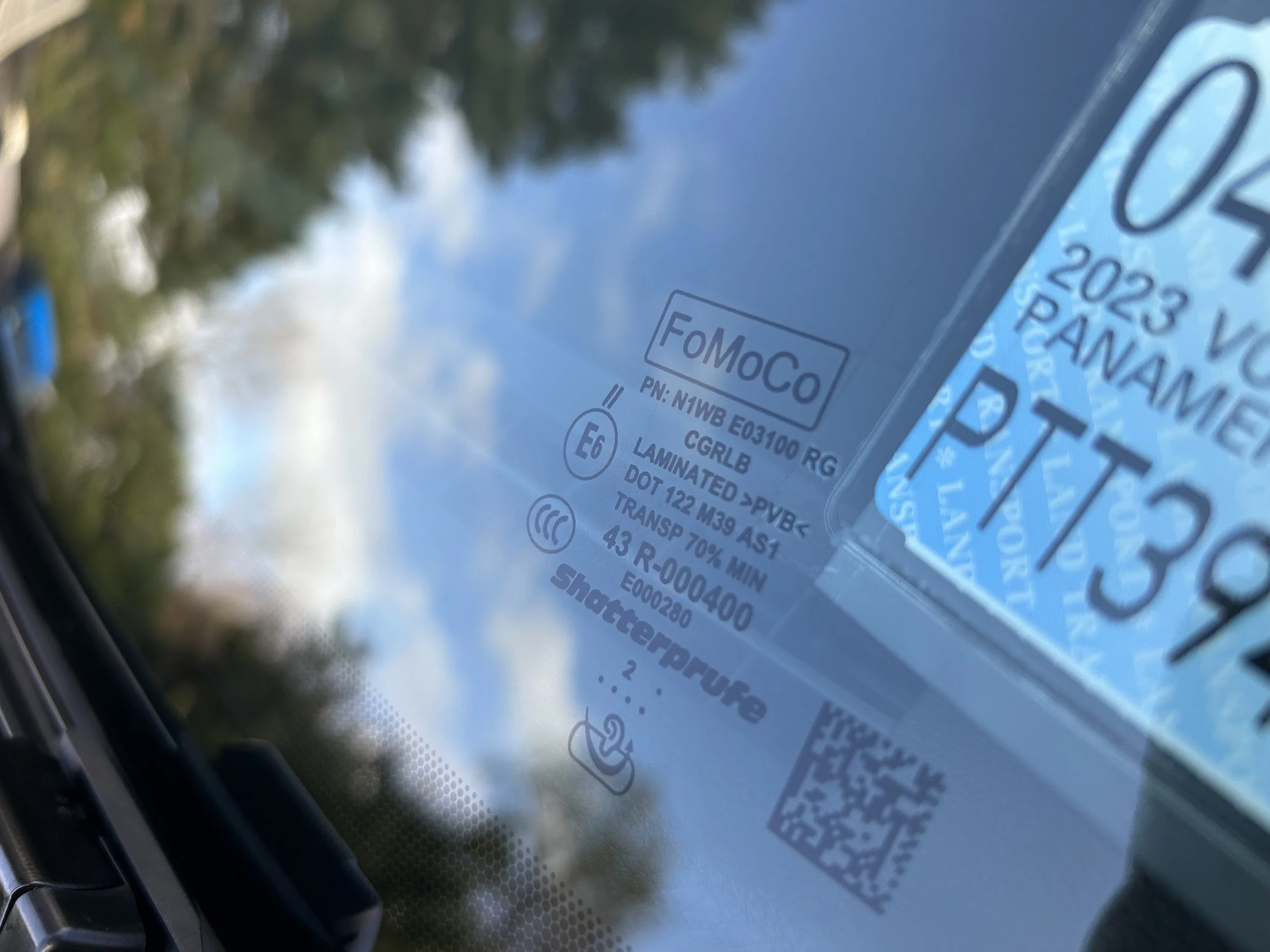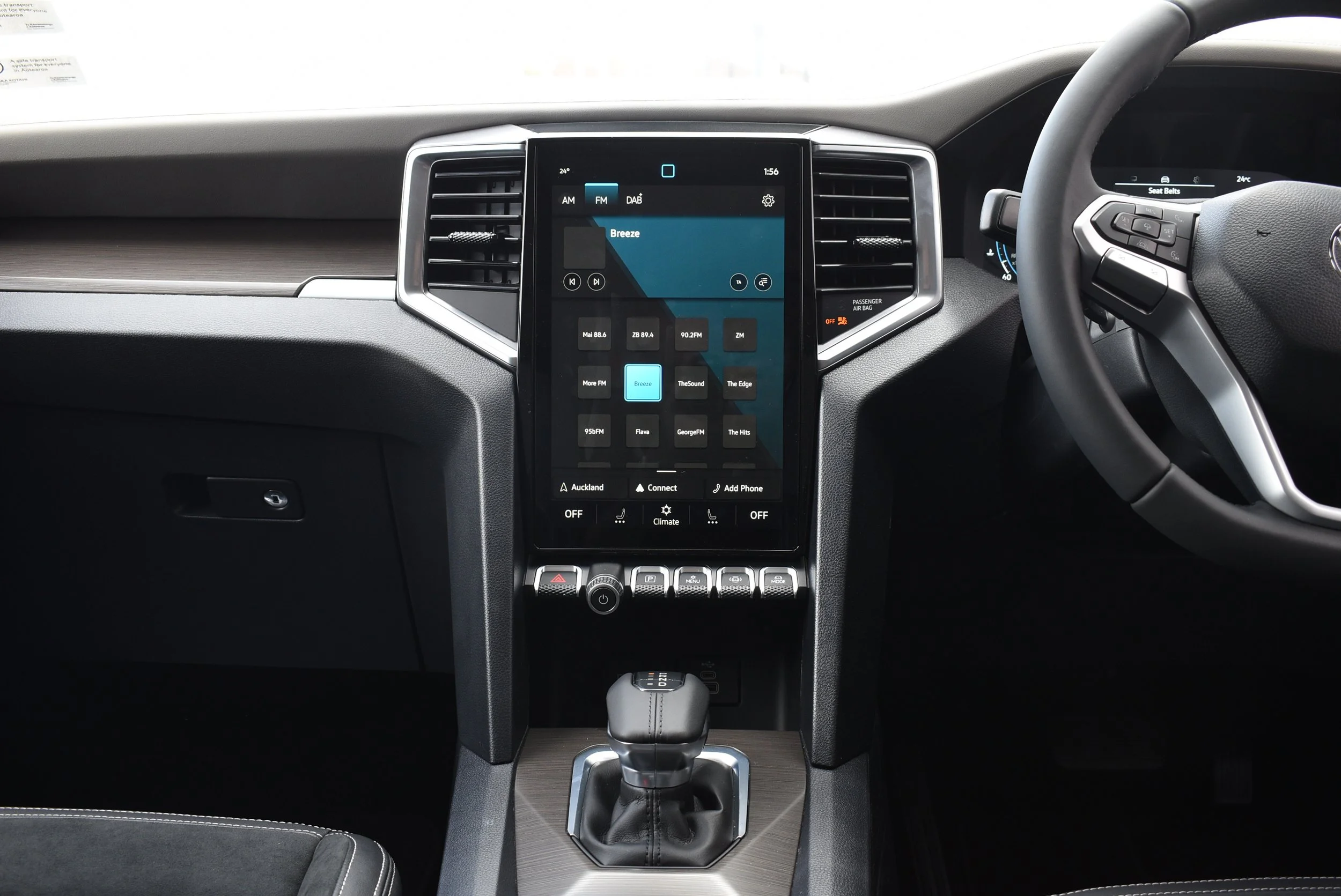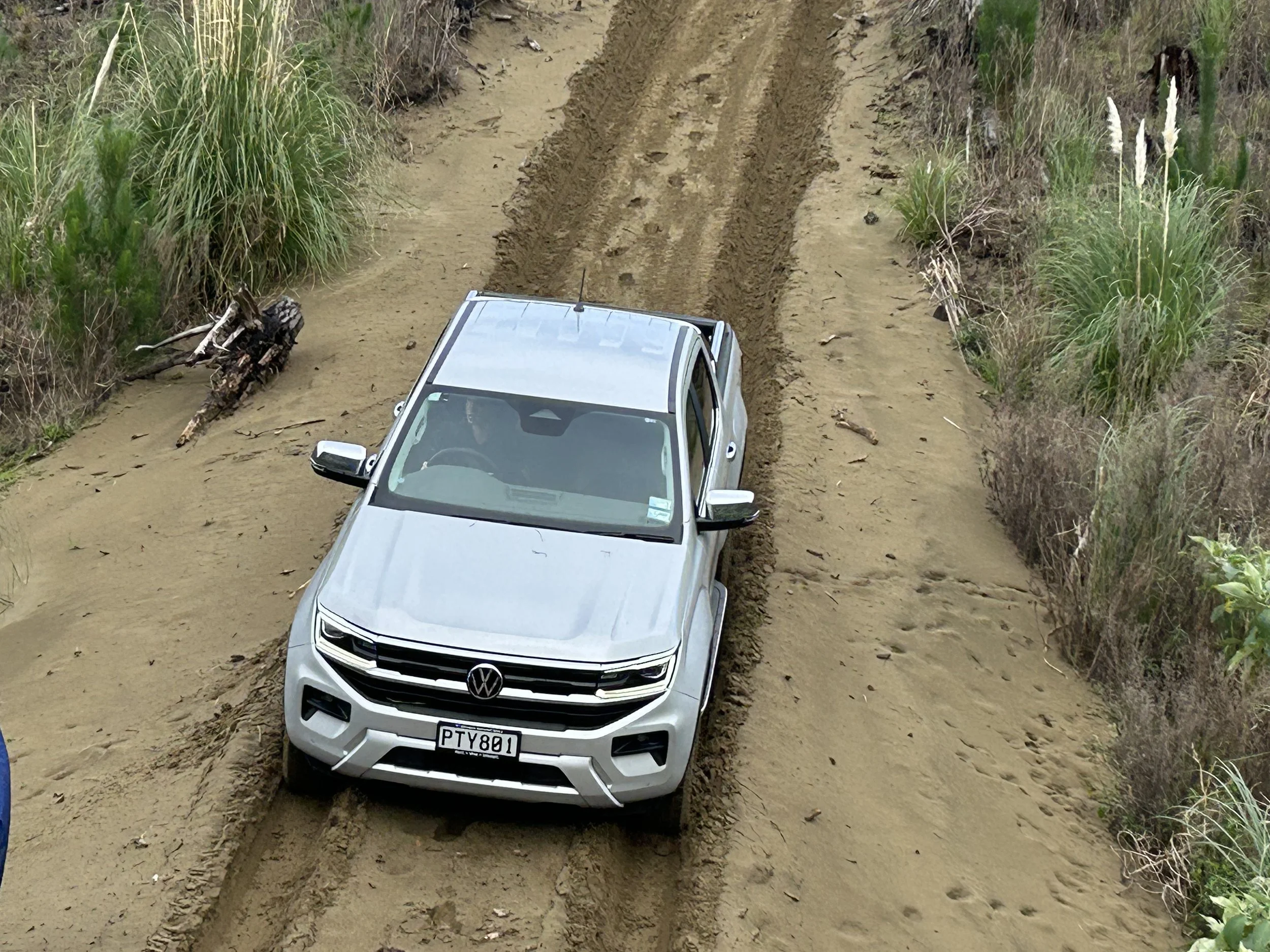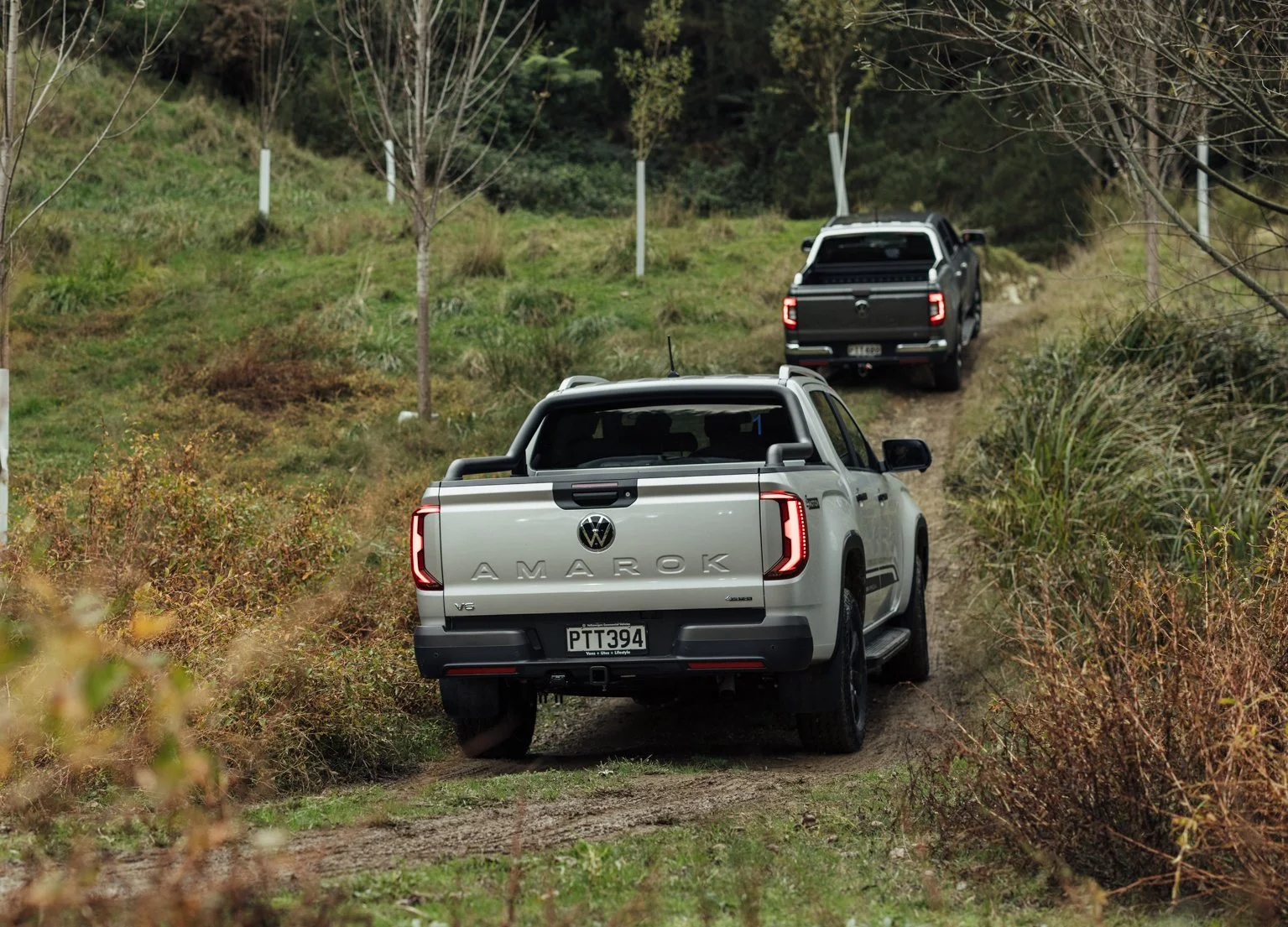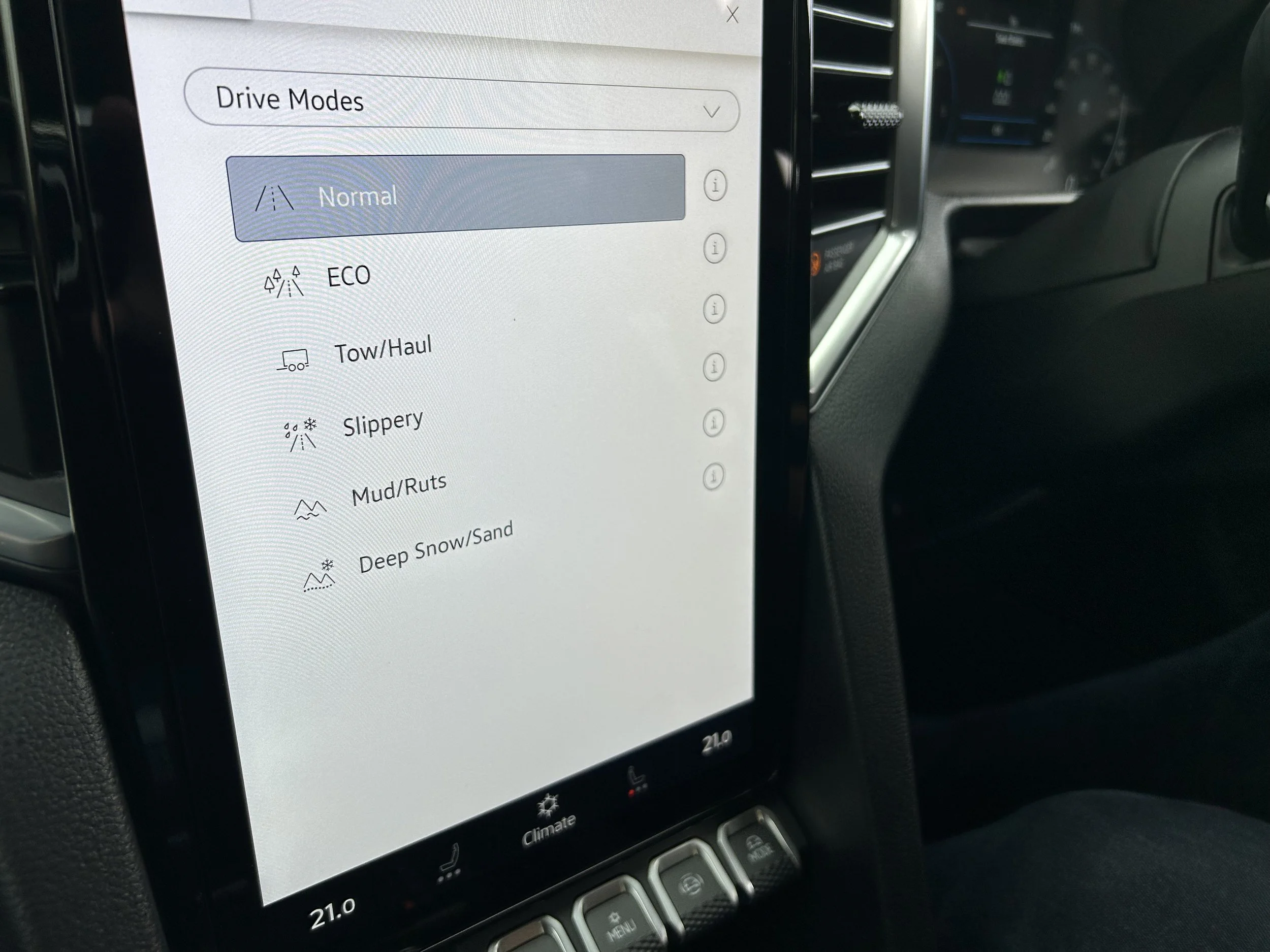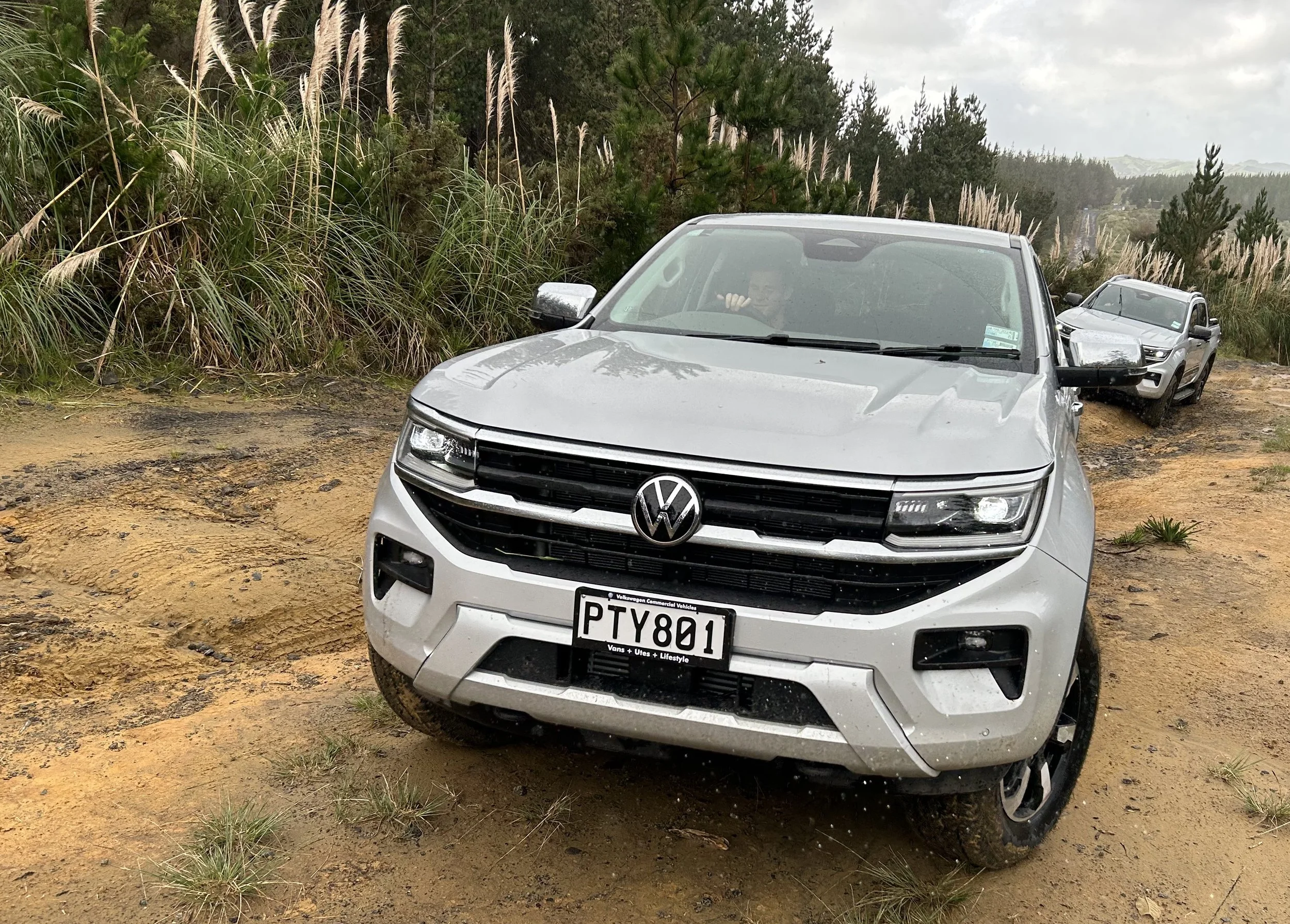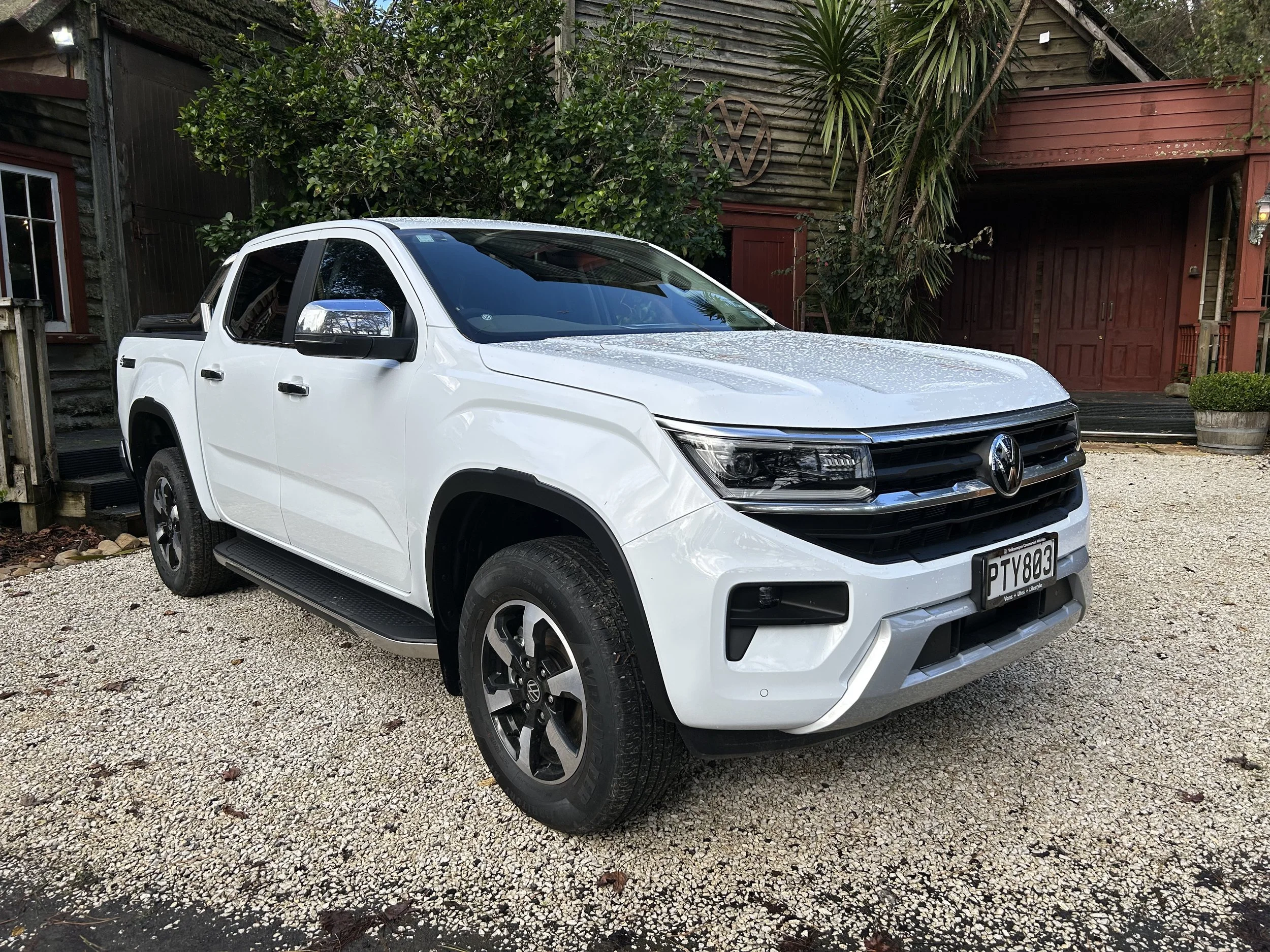VW Amarok first drive: Rok on a roll
/They started with the best – and, in some ways, have made it even better.
TO the Inuit, native to North America’s Arctic, it’s a gigantic wolf said to stalk and devour any person foolish enough to hunt alone at night.
Volkswagen often names products with words from native tribes; it appropriated Amarok because it’s a highly-feared animal that hunts solo.
The background to the second-generation of their one-tonne utility means it’s not so much the latter now.
Still, everything about the model’s Fordification seems so promising; when Ranger is the best, what harm a Rangerok?
Seeing and driving was always going to be the key determinant. A day at the wheel, off road and on, the latter including negotiating flooded highway north of Auckland, with the diesel doublecabs was telling. And largely positive. For me, it evoked the same good vibes felt when meeting the Ford for the first time – almost a year ago to the day, wouldn’t you know.
It’s only a first taste, and proper testing will bring much more clarity, but so far everything I admired about the Ranger then, and ongoing, seems evident in the Volkswagen. Everything I liked and enjoyed about the old Amarok? That’s transferred too.
The perfect ute? Well, better than average. Some stuff asks for improvement. In Amarok, as in Ranger, you’ll curse the clunky transmission shifter design with its propensity to locate to Park when you intend Reverse and the manual mode that’s incredibly user-hostile. The V6 demands paddle shifters and, as old Amarok had those, VW fans will lament the loss even more than Ford buyers who always also query the absence.
The V6s’ constant all-wheel-drive, and its clever condition-bespoke algorithms, is a breakthrough the diesel two litre editions would benefit from achieving. The more expensive models proved to deliver superior condition-sensitivity than the four-pot models’ simplistic on-demand system, to point of showing up instructor insistence about using low-range as being pretty much counter-productive.
Also nuts is that, though basic deck dimensions are identical, Amarok’s tub is j-u-s-t different enough in topside design that it will not accept accessories created for Ranger. Instead, VW has different suppliers … to make all the same stuff.
Overall, though, it’s a very solid effort. The element of fear? Rivals have every reason to feel it.
But how could they not? The base ingredients assured this had to be the best kind of double-down. Ranger is the king; firmly established within the past year as the optimum choice one-tonne ute out there.
Government might be irked by Ford’s ute consistently siting as the country’s top-selling new vehicle, month after month. Utes accounting for 24 percent of the overall new passenger and light commercial tally is an obvious concern for Clean Car and the battle lines are drawn. Yet it’s easy to understand why Ranger has weathered the storm. For those who feel need for a one-tonner, it’s the best by considerable margin.
All that potential assuredly has to help Amarok, though the distributor doubts the consumer demand will be to same scale. Even so, as much as VW Commercials NZ holds no aspiration to challenge Ford NZ’s winning run, it also holds high optimism this new Amarok will be the first to sell more than 1000 units in a year. That’s the aim for 2024. Yes, despite Clean Car. This year’s target is 800-plus. The type’s previous best annual performance so far was 968, in 2018, a tally fuelled almost wholly by the old V6.
About that. Going forward, there’s belief the two … actually, ultimately three (there’s a petrol choice en route) ... turbo four-cylinder power plants it’ll offer with will get as much sales attention as the new 3.0-litre six. A big call, given in old Amarok the previous six-cylinder was so popular it bumped the original twin-turbo four-cylinder out of the scene. Funnily, Ford has been making much the same prediction in respect to their model’s V6-biturbo split. Must be something in the air.
Well, of course there is. Ute tax. If timing is everything, could there be a worse time to hold Amarok’s media launch than a week on from Government hiking emissions’ penalties?
VW’s engines – all Ford powerplants – feel the exactly same impact as Ranger’s. The levy on the entry single turbo 2.0-litre is unclear, but for the same-capacity biturbo it’s $2473 now, climbing to $5232 from July 1. For the V6, $3190 rachets to $6555. Yikes.
VW Commercials New Zealand’s boss, Kevin Richards (above), says it is what it is.
“Obviously we would rather the ute tax had not been increased but we appreciate the rationale behind the Clean Car programme and we just deal with these things as they come to us.”
As much as the V6 was a dominant choice last time, his team had long been confident the new four-cylinders, that are cleaner than the six – but still very much on the Government’s blacklist - would swing buying patterns. “We always thought, even before any change in Government legislation, that the four cylinder had a bigger part to play.
“The way we have ordered and specified the models falls to that. We were roughly 90 percent V6 previously but we see it more 60-40, if not 50-50, split now. These are good drivetrains.”
Back to the first taste assessment. This is badge engineering done with cleverness; for all the obvious sharing, the Amarok and Ranger are far from being complete clones, especially in the looks department.
These being Ford-built is not easily spotted. A quick under-bonnet search for giveaway stampings was fruitless; it was easier to locate VW logos (the first spotted being on the headlamp casings). The most visual affirmation of the tie is at the left-hand bottom corner of the windscreen. There a discreet ‘FoMoCo’ etching reminds it’s out of Ford’s factory in South Africa. In respect to actual external parts commonality, VW pinpoints just the roof, side glass area, door handles and side-mirror caps as being common.
Volkswagen being able to deliver enough changes to keep an ongoing visual link to its highly distinctive predecessor is a real coup. But there it is: The same chiselled face, framed with LED daytime running lights and featuring the company's 'ID. Light' technology. Squared off wheel arches are another carry-over signature.
The Aventura, which has attracted most pre-orders to date, is the smartest looker. Here the front bumper treatment has a silver metallic X-design insert and the brightwork continues through to the door handles and mirrors; even the side step has a polished edge along the side, and the roof rails continue the metallic look.
Within the cabin, the major common element from the donor is the transmission selector. The digital displays are Ford-born, but VW redesigned, Germany having implemented its own infotainment software and bespoke graphics. Hooray for that. It’s a marked improvement.
Amarok retaining digital representations of the old one’s analogue dials is a huge plus point; but the whole approach taken by VW is generally better than Ford’s.
Whereas Ranger’s functions are all touch-operated, VW has sorted a bank of physical buttons along the base of the screen to provide easy access to functions such as volume, driving modes and climate settings. Quirkily, though, temperature adjustment requires a user to press the display rather than adjusting a dial. There is connectivity for Apple CarPlay and Android Auto. A wireless charging pad is included, as are both types of charge ports.
The steering wheel is all VW and of the older style, with physical buttons and not the haptic setup as per the passenger cars.
The indicator and wiper wands being reverse located to enhance the European-ness caught me out more than once – but, then, I’ve just had two weeks with a Raptor.
The front seats having been reshaped, using VW-preferred foams, to meet brand expectation, is welcomed.
The improvements to rear bench shape and legroom that Ranger users have noticed also implement here, though in Amarok the middle seat seems compromised due to the size and design of the centre console. Both outer rear seats have ISOFIX child seat anchor points.
Back-to-back driving with Ranger would be is an exercise likely worth contemplating. When engine outputs are identical, it’s no surprise why VW makes no claim to performance or even economy change.
In respect to VW input, Germany’s design centre handled the styling. Thje front line troops were the 20 engineers sent to Australia for a four-year furlough with the much larger Ranger development team. There they appear to have in the main worked on giving a Vee-dub vibe to the suspension tune.
That was a crucial task. The old Amarok was famously car-like. Notwithstanding the new Ranger is as well, VW reckons their effort is especially true to old form.
Either way, going to the Ford platform has meant a 175mm increase in wheelbase, which makes for tangibly better on-road comfort and stability in either format. Even so, giving an Aventura a brisk burl down a country byway was highly satisfying; it’s still more pick-up than passenger car, but the roadholding and sharp steering feel are above average for the category.
The launch event allowed introduction, with driving involvement, to all the automatic gearbox diesel variants whose names, specifications and prices VW confirmed in February.
The pair of 2.0-litre four-cylinders come with part-time four-wheel-drive in 125kW/405Nm single turbo $65,000 six-speed Life and twin turbo 154kW/500Nm $75,000 10-speed Style. Up a tier are the lifestyle-plus $88,000 Panamerica and $90,000 Aventura with a 3.0-litre single turbo V6, making 184kW and 600Nm of torque, also married to a 10-speed.
VW Commercials New Zealand also announced intent to later this year add another Aventura with a 2.3-litre four-pot turbo petrol – yes, the Mustang and Focus ST engine. Officially this variant is on evaluation, but 20 units are coming, selling for $90k apiece.
Placing that edition a couple of thou short of the one Ranger whose access is verboten, Raptor, will raise an obvious question: Is this VW trying to create a competitor for the hyper-powered, Fox suspension hotrod? If so, it’d be a huge ask.
The petrol Amarok is based on the same underpinnings as the diesel and while the engine makes a handy 222kW and 452Nm, it’s patently not in the same league as Raptor’s 292kW/583Nm 3.0-litre twin turbo V6. It in fact makes 38kW more (but 148Nm less) than the 3.0-litre diesel V6. The 2.3’s real attraction is that it will provide an answer to the small count of buyers who prefer petrol and it will be is the only four-cylinder to have permanent all-wheel-drive.
Still, if anyone knows how to sell upmarket utes, it’s the Germans. The previous Amarok was the first to run a twin turbo four and a V6; the latter edition arguably became the category’s first properly toff traydeck when it arrived with a ZF eight-speed auto plucked from Audi’s limo line.
The rest is history; Amarok V6 was a huge seller to the last. Ranger V6 buyers have VW to thank for that engine being behind a Ford badge; the deal would not have progressed without that concession. Other ‘must keeps’ on VW’s list of demands were others ingredient new to Ranger, but old hat to Amarok: Full time four-wheel-drive with the big donk and rear disc brakes.
So, basically, the way VW spins it, Ranger gains are down to German insistence for quality kit.
That thematic also extends to how Amarok equips. VW holds that its customers expect a bit more than the average ute provisions. All models here standardise with stuff not necessarily seen on all Rangers. A tow bar, rear differential lock, the glam 12 inch display screen in the cabin. It’s why all but the base have LED headlamps, side steps and a deck-attached sports bar.
Adaptive cruise control, lane-keeping aids, rear parking sensors, speed-limit notification, wireless phone charging and nine airbags (five more than the previous Amarok) also provision. Like Ranger it achieves a solid five star ANCAP score, slightly higher on percentage points than the Ford, due to small differences in side impact performance.
Previous Amarok being always all-paw make it a favourite for towing. The new one ups the game in respect to very edition having a 3500kg braked towing capacity, while VW says the permissible total weight of vehicle and trailer has increased from six to 6.5 tonnes.
With that in mind, it’s a pit that initially absent from V6 Amarok is the trick braked trailer controller that works so well in Ranger. An update is coming, but it’s a factory-fit kit, so the first shipment of product cannot be retrospectively altered. As is, Amarok achieves the trailer size and weight programming that allows for finetuning sway control and brake response.
A tailgate that is much lighter than that of the previous Amarok opens to a load area can accommodate a Euro pallet (another VW prerequisite Ford accommodated) and increased weight; 1200kg now. The lashing eyes being able to handle a 400kg tensile load and finishing touches of six load-lashing rings with a tensile load rating of 400kg, a track system incorporating four moveable clamps each with a 250kg limit, LED tray lighting and a high-power electrical outlet in the load bed are Ford initiatives VW has happily accepted.
VW having two plush V6s so closely positioned on price might outwardly seem odd. But it says the provision is in response to understanding there are two kinds of buyer here; those who want to go off-road and those who don’t. The big difference comes foremost down to tyre choice, though there’s also slight difference in suspension tune. Aventura is firmer and on 20-inch rims with road tyres, Panamericana comes with 18s with more rugged all-rounder treads.
That made all the difference in yesterday’s running in Woodhill Forest. Conditions were gnarly; heavy rain had cut out ruts and, even though we were mainly on sand, some spots were slippery. In those places, Aventura was the one that slipped up first.
What helps all editions, though, is that the new platform delivers superior minimal overhangs, so there’s much less chance of banging the bodywork when off the beaten track. The approach angle is 30 degrees, while the departure angle measures 26 degrees. Wading depth increases to a mighty 800mm; good to bear in mind when negotiating flooded roads around Kumeu. On our return trip, some areas were deep enough the seal and centre line were well drowned - as were some road cars. No issue for us.
As in the Ford twin, the six-cylinder’s selectable terrain-specific modes are a work of genius. When you select these, via the touch screen, the vehicle makes all the hardware selections for you, including the transfer case operation and differential locks, and adapts the 10-speed auto’s shift patterns. Trust it.
One upcoming revision for Amarok is its emissions’ standard status. Regardless it has been designed for 180 markets, the donor meets Euro 5. Volkswagen’s corporate policy is to aim higher, at Euro 6.
That will in time see Amarok diesel having to be engineered to incorporate the AdBlue urea supplement. It’s been there before, when production of previous V6 Amarok switched for a while from Argentina to Germany, the examples out of Hanover required the supplement. It’s not expected there will be any change to engine outputs and economy, but emissions might improve.
On that matter, Amarok retail prices are unlikely to be affected by the Clean Car Standard, which pins a CO2 penalty directly onto distributors. Ford NZ is still deciding if it will pass on any CCS pain on Ranger to its buyers. VW here has made clear that it won’t, because it feels any hit can be subsumed into its fleet average.
Amarok no longer being a truly lone wolf is no blight on its character. If anything, joining a pack has improved its hunting skills.
The writer attended this event as a guest of the distributor, with travel, meals and a modest gift provided.


